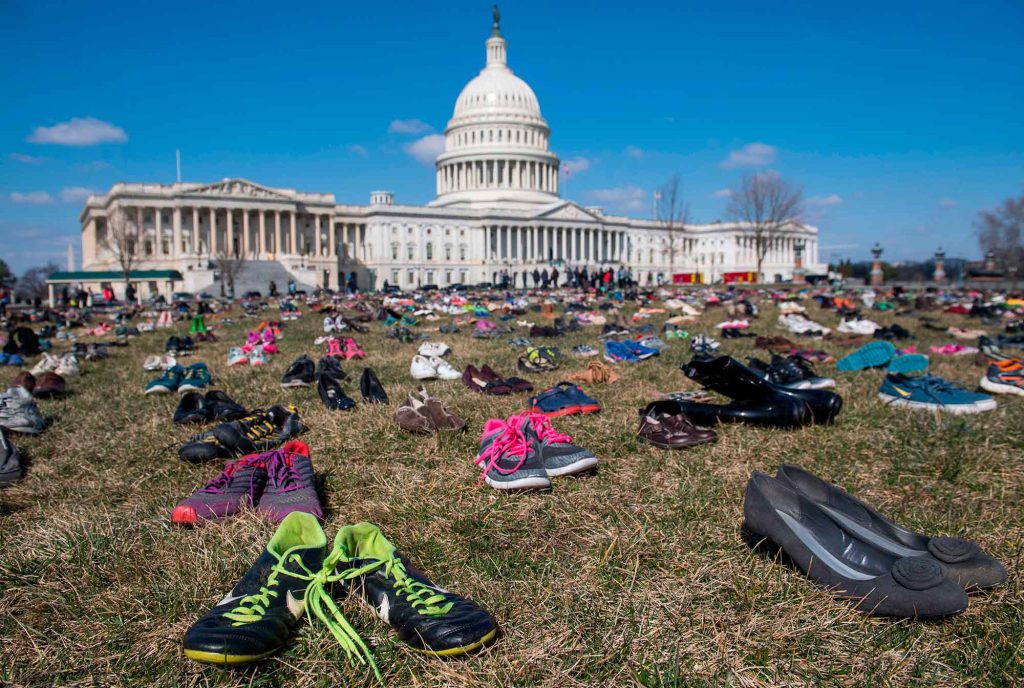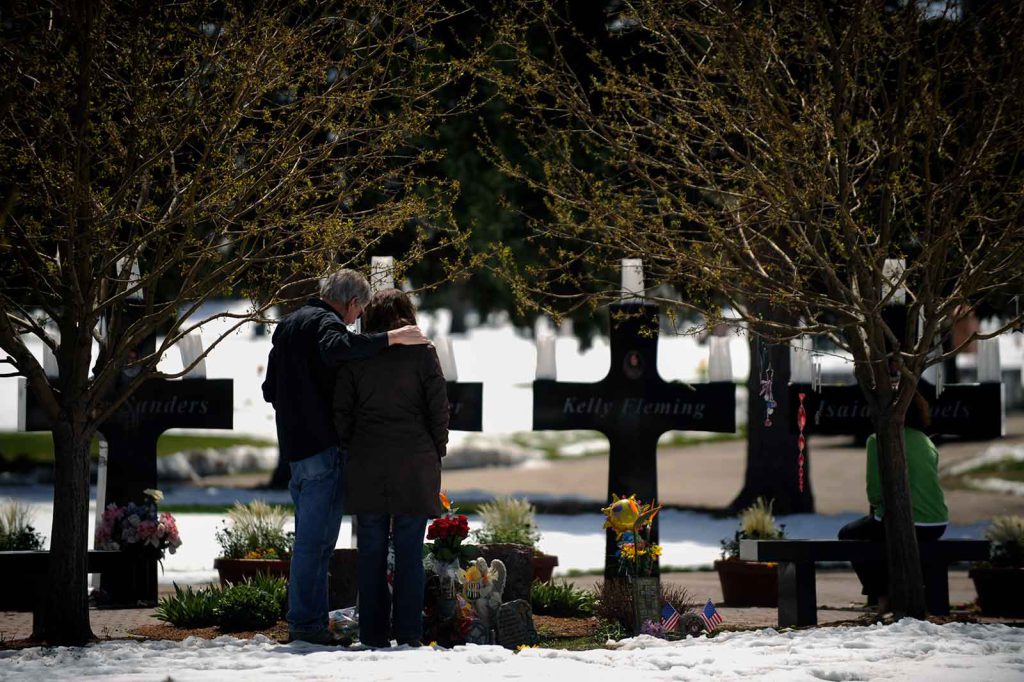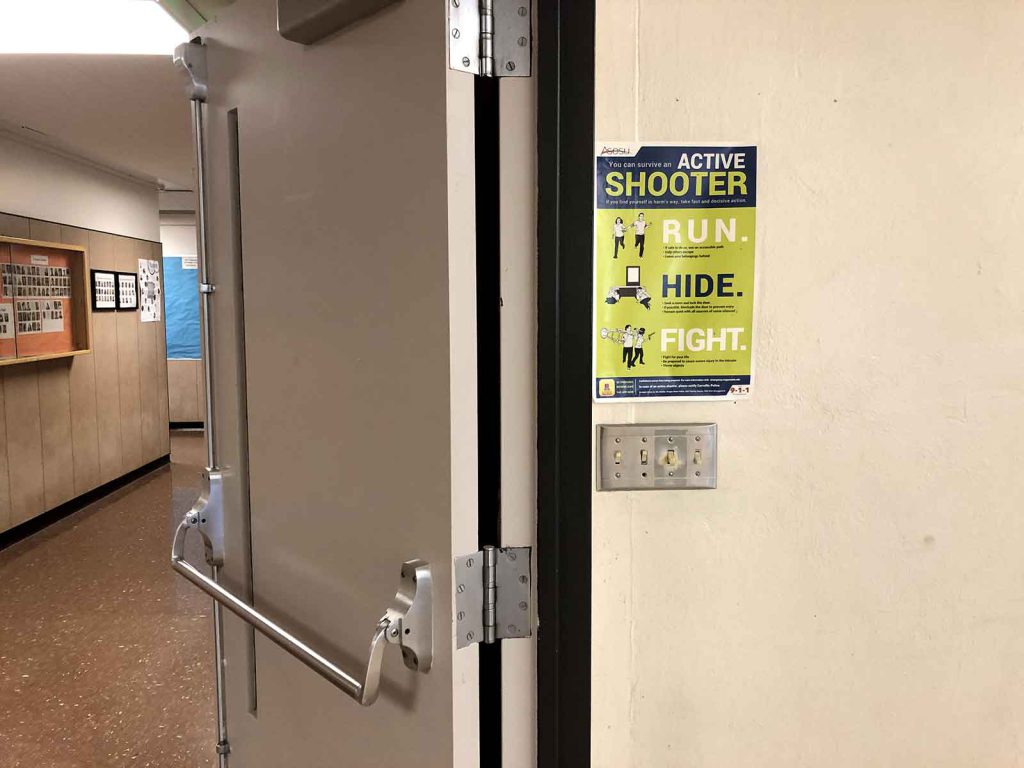Gun Violence Harms, Even if You’ve Never Been Shot

At first, we thought they were firecrackers. Then the blasts grew closer.
Earlier that morning, we’d had an assembly to honor Martin Luther King Jr., which had shortened our classes that day. Rather than break for lunch when the bell dismissed fourth period, two friends and I kept working on a science project. While I was dissecting lichen, a freshman was firing a 9-millimeter semi-automatic handgun into a crowd.
He had begun shooting near the lunchroom on the other side of the school. Now the gunfire moved toward us, loud and near. We didn’t have time to close the door, which didn’t have a lock anyway. Instead, we simply froze. Then the shots passed, grew fainter, and stopped altogether. No one told us it was safe to leave, but we could see people gathering on the lawn outside the classroom window, so we decided to flee, escaping through a hallway where two students had been hit and stray bullets had torn apart the walls.
This shooting happened in 1995, my junior year at Garfield High School in Seattle, Washington—a few years before Columbine High School in Colorado made school shootings a permanent topic of conversation in the United States. Mass shootings were uncommon back then, but there was another school shooting in Washington the following year, then others in Alaska, Mississippi, and Kentucky in 1997, then in Arkansas, Tennessee, and Oregon in 1998. And then Columbine happened in 1999, leaving 21 injured and 15 dead.
Today gun violence is a recognized public health crisis in the U.S.—the American Medical Association declared it as such in 2016. Yet there is almost no research on the long-term impacts of gun violence in schools. In 1996, while the walls of my high school were still under repair, U.S. lawmakers passed the Dickey Amendment, which barred the U.S. Centers for Disease Control and Prevention (CDC) from any activities that “advocate or promote gun control.”
This amendment has effectively prevented any large-scale funding for research related to gun violence. Over 100 different medical organizations have appealed to Congress to overturn it, but so far there have been only nudges in that direction. The U.S. House of Representatives recently passed a bill to allocate US$50 million to gun-violence prevention research, but this is likely to stall in the Senate, where Republicans hold a majority.
As an anthropologist who studies the long-term effects of stress on human health, I am deeply aware of the implications of the Dickey Amendment. They are on my mind when I think back to my own experience of a school shooting and when I teach classes today about the body’s response to stress—with one eye on the door.
In April of this year, a 22-year-old student walked into a biological anthropology classroom at the University of North Carolina, Charlotte (UNC), firing a gun. As of early May, this was the 12th school shooting on a high school or college campus in 2019. Anthropologist Adam Johnson, the instructor of the class, writes of running with students out of his classroom, yelling “active shooter” to anyone who could hear him. Two people in the class died that day.
After I heard the news, I texted a high school friend and asked if she ever thought of herself as a “survivor.” She said she didn’t, and I definitely never do. But I have never taught a course where I haven’t asked myself, What would I do if someone entered my class with a gun?
My current classroom is on the second floor. I don’t think I would break too many bones if I jumped out the window, but would I even get the chance to try? I routinely check to see how easily the window slides open, wondering if I could lift it in a single motion—or if it would get stuck and I’d be shot in the back against the glass. Would it be better to hide behind the podium? My colleagues and I discuss these questions over drinks after work. We’ve heard of bulletproof blankets that we could send with our kids to school; should we get a communal one to store next to us while we teach? Would it help?
When the UNC shooting happened in Johnson’s classroom in May, I was teaching a biological anthropology course at Oregon State University. One of our topics was the physical embodiment of stress. Despite the lack of federally supported research on the physiology of gun-related trauma, we do know that violence influences bodies—in sometimes unexpected ways. For example, research has linked the heartache of childhood adversity to the literal breakdown of the human heart through later-life cardiometabolic disease. Constant low-grade environmental stressors from a lifetime of exposure to harmful social conditions, such as racism or sexism, can cause cellular damage with effects on physiological health. Single stressful events can also magnify over time, with devastating effects on the body. Some impacts can even be passed down to future generations.
Near the end of the term, I say to my class, “When I speak of living with chronic stress, I’m not talking about anxiety during finals week,” hoping to ease students’ worries that the stress of the classroom might be harming them. Then I add, “This is a different order of stress than you’re experiencing here.” But later that period, someone drops a book in the hallway, and I see everyone startle. These are students who were raised in the shadow of the Sandy Hook Elementary School massacre, who are used to active shooter drills, and who have learned, since they were little, to “run, hide, fight.”
My own expertise is in nutrition-related diseases such as diabetes and cardiovascular disease, both of which policymakers commonly associate with the food that we eat. But body fat, for example, isn’t just a result of food: It depends on many other things too, including stress hormones. Fat is an endocrine organ that both secretes and absorbs chemicals, highlighting the complex interactions that exist between stress and our metabolic, circulatory, and nervous systems. Some scientists have begun to refer to gun violence as a “biopsychosocial disease” to draw attention to the broad physiological and mental toll that guns inflict.
Gun violence in the U.S. today is not only the brutality of bullets ripping through flesh.
There is good reason to wonder what living in a country that is chronically anxious about gun violence is doing to U.S. bodies and minds. Yet the federal government, ignoring this public health framing, does not support research on the health effects of living in a country where mass shootings are a daily occurrence.
Gaps in knowledge are unlikely to be filled elsewhere. Private and philanthropic foundations, along with individual states, have contributed some funding to gun violence research, but this does not come anywhere close to addressing the scale of the problem. Neither can the U.S. count on other countries to study the effects of widespread gun violence: In most countries with robust national research and development funding, gun violence is not a public health emergency.
Not everyone lives in chronic fear that gun violence will affect their children and their schools. I know this because I divide my academic time between Oregon and Amsterdam. Last year in Amsterdam, at my son’s kindergarten school play, the kids ran around with black cap guns that looked pretty real to me. I was aghast—guns in school? The other parents laughed off my surprise, saying, “Let them play,” and “It’s just fantasy.” And for the most part, in Amsterdam, they are right—it is just fantasy. The Netherlands has strict gun laws, with extensive background checks, mandated safety courses, and lengthy waiting periods for permits. While 57 school shootings have been reported in the U.S. so far in 2019 alone, I could find evidence of only three shootings in schools in the Netherlands ever, only one of which led to a fatality.
Meanwhile, in the U.S., the culture of guns and denial of their impacts continues. A few days after the UNC shooting, campus Republicans at Oregon State held a public recruitment event in the central plaza, where they sold raffle tickets to win an AR-15. I could see them from the window of my classroom, along with the signs representing the gun. They didn’t mention the average annual 63 gun-related homicides or the 378 gun-related suicides in the state, or that gun violence cost Oregon taxpayers roughly US$2.6 billion dollars, according to a study produced by the Giffords Law Center to Prevent Gun Violence.
One wintry day in 2018, Oregon State sent around a campus-wide alert warning people to stay inside, and the campus day-care center that my youngest child attended went into lockdown. Police later arrested a former student who had tweeted his intention to shoot up the campus. Today my kids come home from school repeating, “locks, lights, out of sight.”
One thing we do not need to study is the origin of the gun violence epidemic in the United States. This is already well-understood. Gun violence is caused in large part by the gun industry, whose lobbying has encouraged increasingly dangerous guns to proliferate at a terrifying rate. (See, for example, this time lapse visualization of the U.S. arms trade from 1950–2017.) This industry has ensured that the sale of guns in the U.S. goes largely unchecked. People often blame mental illness, but that is an irresponsible narrative. In fact, people with mental illness are more likely to be victims of violence than its perpetrators.
What we do need to study are the long-term consequences of the trauma of living in a country full of guns—particularly for black communities and other communities of color that are disproportionately affected by gun violence, and for women, who are victimized by firearms in many ways, including through intimate partner violence.
The systemic defunding of gun violence research makes it hard to tell anything except case-based stories about life in the aftermath of school shootings. But case-based stories are piling up. Decades since an angry freshman fired 14 shots into the crowded hallways of my school, injuring two people, I’m now among hundreds of thousands of people who have heard gunfire in their schools and among the millions who have experienced shootings in the U.S. who would be justified for being shaken by the drop of a book.
Gun violence in the U.S. today is not only the brutality of bullets ripping through flesh. It is also the damage of anxious classrooms filled with generations of students who come to school believing that their lives are less valuable to their political leaders than guns. Many of my U.S. students worry about when they will be directly affected by a school shooting, without realizing they have already been affected. A critical question for people in the U.S. today is not only “When will the next shooting happen?” but also “What are you doing to heal the trauma your schools have already endured?”
For now, one response is clear: As the most recent funding bill goes to a vote, U.S. citizens must convince their senators to finally treat gun violence as the critical public health crisis that it is.



































